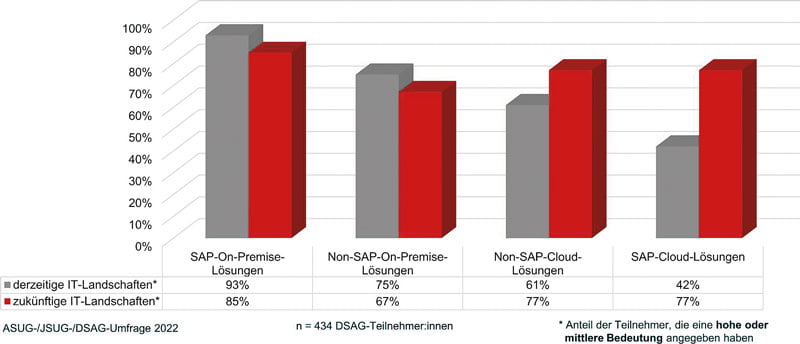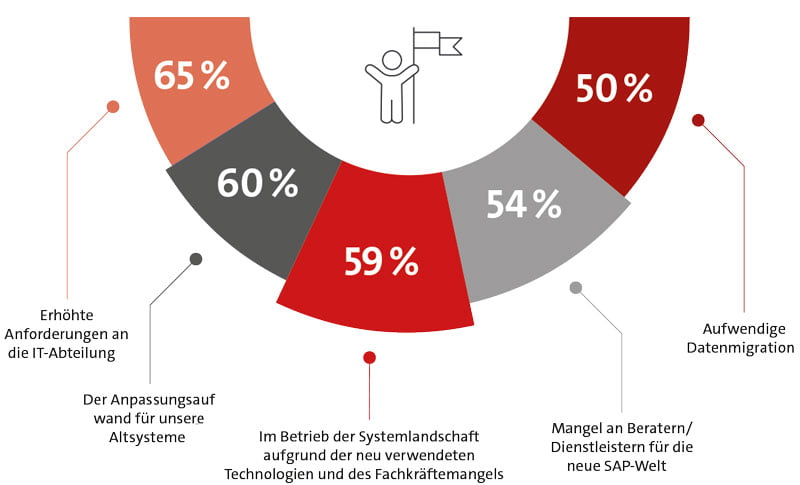

DSAG Annual Congress 2022: In search of success and the future of cloud computing
The DSAG user association surveyed its members in parallel with similar surveys conducted by the Japanese and US user groups. The majority of the surveyed association members in all countries are able to keep pace with digitization, transformation and the changing times. In terms of the importance of solutions, the on-prem approach is naturally still the undisputed leader in German-speaking countries, although SAP cloud solutions are also gaining ground. "More transparency" is, however, what DSAG would like to see in cloud contracts, roadmaps and product strategy. In addition, the complex transformation process still needs to be accompanied much better by SAP. Thus, the search for success goes into overtime, including a search for the definition of "hybrid cloud".
What still sounded like "cloud only" and "cloud first" at the DSAG Technology Days in Düsseldorf in May of this year is now being sold by SAP as "hybrid cloud" - but without a precise definition of it: Thus, many participants were puzzled in Leipzig at the DSAG Annual Congress as to what exactly SAP CEO Christian Klein and his fellow board member Thomas Saueressig meant. It is unclear which IT philosophy SAP will follow in the future. However, due to digitization, transformation and the political turn of the times, the success of companies depends on how they can keep pace with change. According to a survey by the German-speaking SAP User Group, Americas' SAP User Group and the Japan SAP User Group, 85 percent of the member companies surveyed are succeeding well.
On-prem vs. cloud future
However, on-prem systems are still of great importance, even if cloud solutions are gaining ground: The future of IT is hybrid! At the DSAG annual congress in Leipzig, Christian Klein and his fellow board member Thomas Saueressig explained via video link that SAP is naturally prepared to think in hybrid dimensions and that on-prem systems naturally have their justification. In view of the figures collected by the user association, the two board members also had little choice. A large proportion of DSAG members want to remain on on-prem systems. Thus, the discussion focused on the term "hybrid cloud" - but without SAP offering a definition of this either-or answer.
For companies and organizations to keep pace with change, IT departments and landscapes must also be adapted accordingly. When asked about the software providers that are most important to DSAG members in this context, SAP is ahead of Microsoft, followed by Oracle, Salesforce, and Amazon Web Services and Google. SAP and Microsoft also occupy the first two places among ASUG and JSUG participants. SAP is probably still secretly hoping for a resounding cloud success, but this is moving into the distant future with this gain in knowledge from the DSAG annual congress.

In a completely overcrowded lecture hall, a Munich lawyer explained to the existing SAP customers who had traveled to Leipzig what is written in small print in the SAP cloud contracts: One day after the end of the contract term, SAP is entitled to delete all data in the cloud. As a precaution, cloud users will have no choice but to withdraw their data from the cloud and back it up with appropriate advance notice. Which brings us back to the lack of a cloud exit strategy, which E-3 Magazine already addressed two years ago and has been missing ever since. When asked about the importance of SAP and non-SAP solutions, both on-prem and in the cloud, SAP on-prem solutions have a high and medium importance for the current IT landscapes at 93 percent of the DSAG member companies surveyed.
Although a full-service offering can be presented with Rise with SAP, the German companies surveyed by Techconsult during the same period are struggling to find the right model for themselves. Cloud is not just cloud. Because a differentiation must also be made in cloud deployment. When entering the cloud, companies are faced with questions about standardizing the IT landscape according to best practice or maintaining the high level of individualization in the IT architecture. At the same time, questions of migration arise here, which are strongly related to the corresponding deployment model. The analysts at Techconsult are convinced that an S/4 transformation cannot be mastered by companies on their own.
SAP's cloud strategy is an immature, poorly communicated and incomplete offer to the SAP community. Resentment among existing customers and partners is high, yet the DSAG annual congress was largely harmonious between SAP and DSAG - but not all DSAG members were willing to accept this. Some wished for more resistance and opposition to SAP. DSAG Executive Board member Thomas Henzler gave a much-praised and sharp-tongued keynote address in Leipzig. He put his finger in the wound and called on SAP to make many improvements. However, this critical and constructive stocktaking by Thomas Henzler did not seem sufficient to all DSAG members. The fact is that SAP is bringing a lot of unrest into the community with this no-fish-no-meat policy and is contributing to a lot of unrest and uncertainty among existing customers with its current cloud strategy.

S/4 Conversion
The challenges of the S/4 transformation vary between the planning and implementation phases. Problems that are relevant during planning may be exacerbated during implementation, but are primarily of a strategic nature for the company. Many companies find it very difficult to prepare internally for the challenges of the S/4 transformation. In particular, the competencies required in the specialist departments are developed too late and other relevant stakeholders from the specialist departments (in addition to management and IT) are involved too little in the transformation. Other significant hurdles are the questions about the transformation sequence and the responsibilities in the business departments. Most of the time, these are taken at management level, but after management has taken the initiative, the needs of the affected stakeholders and decision-makers are taken into account too little or too late.
"However, it is precisely the affected business units that provide the necessary expertise for mapping business processes that are affected or need to be optimized and have a significant influence on the identification of processes with lower added value," says Waldemar Klassen, an analyst at Techconsult. Asked about the importance of software solutions for companies' future IT landscapes, of the DSAG participants surveyed, 85 percent attest high and medium relevance to SAP on-prem solutions, 77 percent to SAP cloud solutions, and the same number to non-SAP cloud solutions.
"The importance of SAP on-prem solutions will continue to decline, but will still remain at a high level. However, since cloud solutions are becoming more important at the same time, this confirms the trend that we have already been observing for a few years: The future is hybrid!", says Jens Hungershausen. It is important, he continues, that companies are supported with appropriately integrated and affordable scenarios based on adequate licensing and data models as well as processes.
CCoE, ALM and Hyperscaler
From SAP, the DSAG association would like to see transparent, flexible and scalable cloud contracts with the corresponding metrics, as well as binding statements and roadmaps on product strategy in the cloud and on-premise. In addition, with regard to hybrid landscapes, there is a need for clear models for integration and operation with ALM, SAP Application Lifecycle Management. This also includes collaboration models between the CCoEs and the hyperscalers. Especially the function of the Customer Center of Expertise in connection with the SolMan replacement and ALM functionality will be in demand again next year.
"New SAP solutions and hybrid approaches must not create a process vacuum. It is important that SAP helps to prevent this vacuum," says Jens Hungershausen. Finally, the CEO also sees potential in terms of transformation: "In our view, Rise with SAP still has a lot of potential. The wish would be for SAP to provide even stronger and better customer-specific support for the complex transformation process right from the start. This also includes involving partners more quickly and better across the board."






